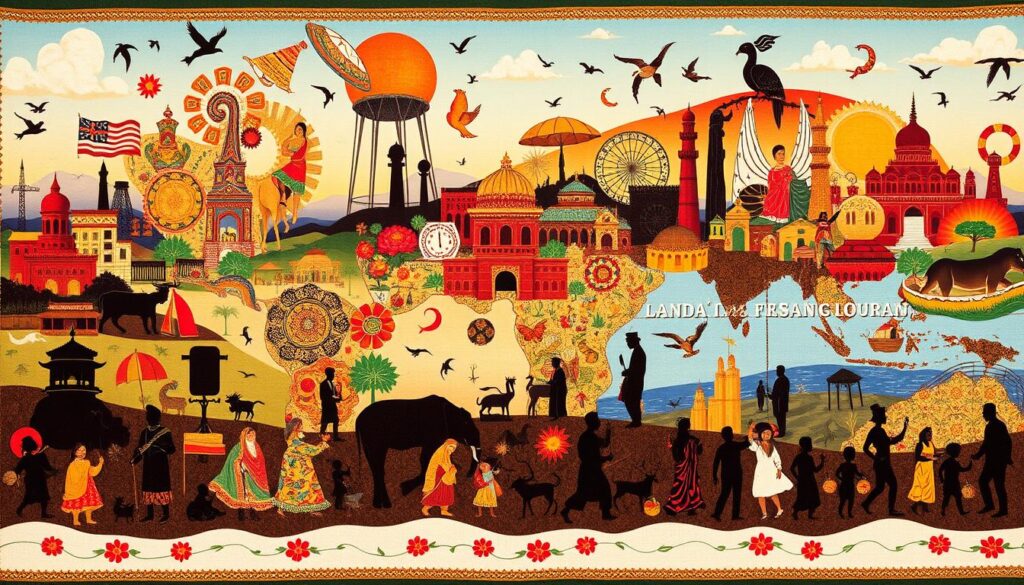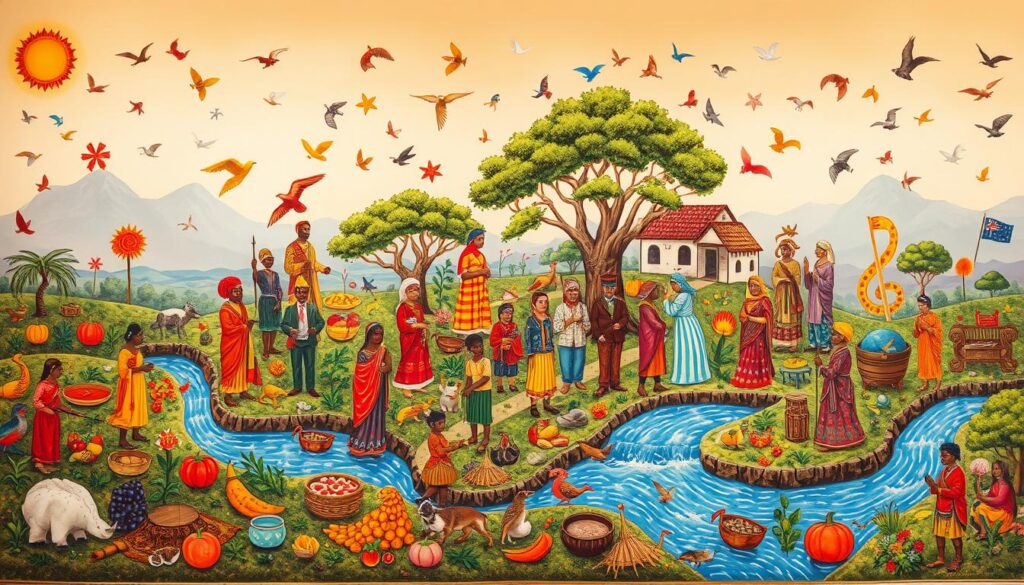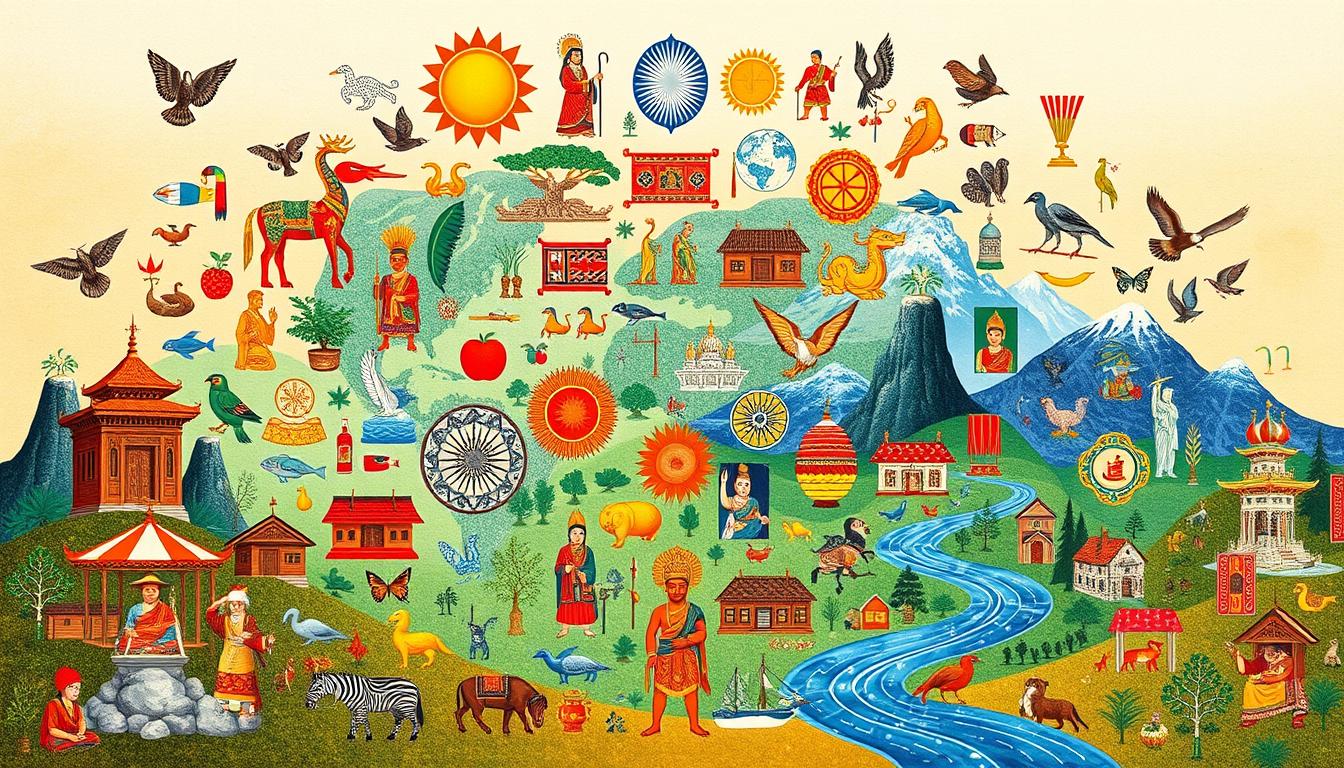In today’s interconnected world, personal relationships often cross borders and boundaries. They bring together individuals from various cultural, ethnic, and national backgrounds. While these connections can be incredibly enriching, they also present unique challenges due to cultural differences. It’s crucial to navigate these disparities with empathy, respect, and an open mindset to foster harmonious and fulfilling relationships.
As a researcher, I’ve seen how cultural diversity can both enrich and complicate our personal connections. The language we speak, the traditions we cherish, and the values we hold dear all shape our worldviews and behavior. Yet, embracing and understanding these variations unlocks the true beauty of diversity.
Key Takeaways
- Navigating cultural differences in relationships is essential in our interconnected world.
- Cultural diversity can both enrich and complicate personal connections.
- Understanding and respecting cultural differences is key to fostering harmonious relationships.
- Developing cultural awareness and communication skills can help bridge cultural gaps.
- Embracing diversity and finding common ground are vital to navigating cultural differences.
The Beauty of Diversity: Cultural, Ethnic, and National Differences
The world we inhabit is a vibrant tapestry of diverse cultures, ethnicities, and nationalities. Each contributes to the rich mosaic of human civilization. This diversity showcases the ingenuity and resilience of the human spirit. It allows us to explore different ways of life, expand our perspectives, and gain a deeper understanding of the world.
Every corner of the globe offers a unique lens through which we can view the human experience. From the vibrant traditions of indigenous communities to the globally influential metropolises, each place has its own distinct charm. Whether it’s the intricate language patterns, captivating art forms, or time-honored rituals, each culture adds to the global cultural richness.
Embracing this diversity is more than tolerance; it’s a celebration of our interconnectedness. By immersing ourselves in the world’s cultural tapestry, we cultivate empathy, appreciation, and mutual understanding. These are the cornerstones of meaningful relationships and a harmonious world.
| Cultural Diversity | Ethnic Diversity | National Diversity |
|---|---|---|
| The vast array of customs, traditions, and ways of life that define a community or region. | The diversity of racial, linguistic, and ancestral backgrounds within a population. | The multiplicity of sovereign states, each with its own unique history, political system, and national identity. |
As we navigate the rich landscape of cultural, ethnic, and national differences, let us embrace the opportunity to learn, grow, and create lasting connections. For it is in the celebration of our diversity that we find the true beauty and strength of the human experience.
“Diversity is not about how we differ. Diversity is about embracing one another’s unique-ness.” – Ola Joseph
Challenges of Navigating Differences in Personal Relationships
Cultural diversity enriches personal relationships but also brings challenges. Misunderstandings, conflicts, and strained dynamics can occur when communication styles, social norms, family values, gender roles, and core beliefs clash. Understanding and respecting our differences is key to navigating these complexities.
Communication Styles
Cultures differ in communication norms, from direct to indirect speech, and in the use of humor and body language. What’s polite in one culture might be seen as rude in another, leading to misinterpretations and hurt feelings. It’s essential to bridge these communication gaps for effective dialogue.
Social Norms and Etiquette
Gestures, customs, and social etiquette vary greatly across cultures. Actions considered acceptable in one context might be offensive in another. Navigating these nuances requires patience, flexibility, and a willingness to learn and adapt.
Family Dynamics
The role of family and extended family in personal relationships varies significantly. Balancing individual needs with familial obligations is complex when cultural expectations differ. It’s crucial to respect and accommodate these differences for harmonious cross-cultural bonds.
Gender Roles
Cultural attitudes towards gender roles and relationships influence partnership expectations, often leading to disparities in decision-making and responsibilities. Navigating these dynamics requires open communication, compromise, and a shared commitment to equality and mutual understanding.
Values and Beliefs
Core values and beliefs, including religious and ethical perspectives, can differ significantly across cultures. Respecting these differences while maintaining one’s convictions is challenging but crucial for fostering genuine cross-cultural connections.
Overcoming these challenges requires a willingness to learn, adapt, and embrace the unique richness that cultural diversity brings to personal relationships. By cultivating cultural awareness, open communication, and a spirit of compromise, we can navigate the complexities and celebrate the beauty of cross-cultural connections.
Navigating cultural differences in relationships is a delicate and rewarding endeavor, as it allows us to expand our horizons and forge meaningful connections across diverse backgrounds.
Navigating Cultural Differences: Strategies for Success
Exploring cultural differences in relationships can be both rewarding and challenging. With the right approach, you can forge strong, cross-cultural bonds. Let’s delve into the essential steps for success.
Cultivate Cultural Awareness
Understanding your partner’s cultural background is key. Learn about their heritage, history, and values. This knowledge helps you avoid assumptions and approach differences with respect and curiosity.
Open Communication
Creating a safe dialogue space is vital. Encourage both partners to share their views and concerns openly. This mutual understanding is the foundation of a strong, cross-cultural bond.
Active Listening
Active listening bridges cultural gaps. Listen attentively to your partner’s experiences and perspectives. Respond with empathy, showing that their voice matters.
Flexibility and Compromise
Adapting and compromising are essential. Seek common ground that respects both cultures. This approach ensures mutual understanding and satisfaction.
Patience
Building cross-cultural relationships demands patience and effort. View the journey as a collaborative growth process. Overcome challenges together, committed to mutual understanding.
Respect for Diversity
Value cultural diversity and approach differences with curiosity. Celebrate the unique aspects each partner brings. Foster an environment of acceptance and appreciation.
Seek Third-party Support
If issues arise, consider professional help. Counselors or mediators with cross-cultural experience can offer valuable guidance. They help navigate complexities more effectively.
By adopting these strategies, you can confidently navigate cultural differences. This approach fosters a thriving, cross-cultural relationship that celebrates diversity’s richness.
The Importance of Understanding Culture: A Comprehensive Exploration
Culture is a complex tapestry that deeply influences our worldviews, behaviors, and relationships. Exploring this intricate construct is essential for understanding cross-cultural connections. It helps us foster deeper connections between individuals.
What Exactly Constitutes Culture?
Culture is the shared patterns of behaviors, social interactions, and cognitive frameworks within a community. It is shaped by historical developments, religious doctrines, geographical settings, and linguistic nuances. This complex web provides a sense of identity and community. It also guides our interactions and relationships through unwritten rules.
How Culture Acts as a Prism for Worldview and Behavior
Imagine culture as a prism that refracts our experiences. It colors our morals, ethics, and societal norms. The cultural influences on our worldview and behavior are deeply ingrained. They shape how we express affection, adopt roles, and handle conflicts.
The Indispensable Role of Culture in Relationships
In multicultural relationships, understanding each other’s cultural influences is key. It prevents misunderstandings and adds depth to the relationship. By acknowledging the role of culture in relationships, couples can develop empathy, flexibility, and appreciation for each other’s unique perspectives and traditions.
“Culture is the foundation upon which we build our lives. It is the lens through which we view the world, and the framework that shapes our behaviors and relationships.”

Understanding culture is vital for cultivating meaningful relationships. It helps us transcend boundaries and celebrate the diversity that enriches our lives.
Navigating the Common Cultural Differences in Relationships
Understanding cultural differences is vital for a harmonious partnership. These differences appear in communication styles and family expectations. Recognizing these differences early helps couples address them effectively, strengthening their bond.
Communication Styles: More Than Just Words
Expression of emotions and ideas varies across cultures. Some cultures value open expression, while others prefer subtlety. Being aware of these styles can prevent misunderstandings and enhance emotional connection.
Gender Roles: Navigating Tradition and Modernity
Traditional gender roles still influence many relationships, despite global shifts towards equality. These roles can create complexity, as personal views and experiences may differ within the same culture.
Family Values: The Backbone of Cultural Beliefs
Family values reflect cultural norms and impact relationships. In some cultures, the extended family plays a significant role. Others prioritize the nuclear family’s independence. Understanding these differences is crucial for navigating cultural nuances in relationships.
Respecting cultural differences is essential for building a resilient partnership. Open communication, flexibility, and compromise are key. They help couples overcome the challenges of cultural differences, fostering a stronger bond.
Navigating Cultural Differences in Relationships
Understanding and managing cultural differences is crucial for successful cross-cultural relationships. It’s about recognizing the impact of cultural diversity and actively bridging gaps. This journey requires patience, empathy, and a readiness to adapt in relationships that span cultural, ethnic, or national lines.
Ignoring cultural differences can lead to friction and misunderstandings. Yet, when managed well, these differences can add depth and appreciation for each other’s backgrounds. The essence lies in fostering cultural awareness, engaging in open dialogue, and embracing flexibility and compromise.
- Develop Cultural Awareness: Educate yourself about your partner’s cultural traditions, values, and beliefs. This understanding is the first step in effectively navigating cultural differences.
- Encourage Open Communication: Create a safe space for honest discussions about cultural differences. This allows both partners to share their perspectives and concerns openly.
- Practice Active Listening: Actively listen to your partner, aiming to understand their experiences and viewpoints. This approach is more about listening than waiting to speak.
- Embrace Flexibility and Compromise: Show a willingness to compromise and find creative solutions that respect both partners’ cultural backgrounds and preferences.
By tackling cultural differences with patience, empathy, and a desire to learn, couples can build a strong, resilient, and enriching relationship. This is built on trust and mutual understanding.

“Differences are not intended to separate, to alienate. We are different precisely in order to realize our need of one another.”
– Desmond Tutu
Unpacking the Complexities of Cross-Cultural Relationship Challenges
Cross-cultural relationships bring a rich tapestry of experiences and perspectives. Yet, they come with complexities that demand mutual understanding and respect. Navigating religious differences and finding common ground in lifestyle choices is just the beginning. The journey to a thriving relationship is filled with both joy and obstacles.
Navigating the Tangled Web of Religious Differences
Religion deeply influences an individual’s worldview and moral standards. For some, sharing the same faith is crucial, forming the relationship’s foundation. Others must find ways to respect and honor each other’s beliefs, even if they differ.
Food for Thought: Handling Dietary and Lifestyle Choices
Food is a powerful symbol of cultural identity. Differences in diet, based on religious or lifestyle choices, can strain relationships. These tensions often surface during family gatherings or holidays, requiring sensitivity and accommodation.
The Complexities of Language Barriers
While love transcends language, everyday communication is a challenge when languages differ. Language is key to relationship dynamics. Overcoming language barriers is essential for a relationship to flourish.
Addressing challenges in cross-cultural relationships requires patience, empathy, and a commitment to understanding each other’s cultures. Whether due to religious differences in cross-cultural relationships, dietary and lifestyle differences in cross-cultural relationships, or language barriers in cross-cultural relationships, the effort is worth it.
The Role of Couples Counseling
Navigating cross-cultural relationships is a journey filled with rewards and challenges. Couples counseling plays a crucial role in this journey. It offers a supportive space for partners to explore and celebrate their diversity.
The importance of therapy in cross-cultural relationships is immense. Couples counseling provides professional guidance and strategies to address cultural differences. It helps partners develop a deeper appreciation for their backgrounds and find common ground.
Experienced professionals guide couples to cultivate cultural awareness and respect. They learn to be flexible and compromise, overcoming hurdles like religious differences and language barriers. This approach empowers partners to navigate cultural complexities together.
“Couples counseling is not just a tool for resolving conflicts; it’s a gateway to a deeper understanding and celebration of the rich tapestry of cultures that make up a relationship.”
Embracing couples counseling unlocks the beauty and resilience in cross-cultural relationships. With professional support, partners can navigate cultural differences and emerge stronger. They forge a relationship that truly values diversity.

In conclusion, couples counseling is essential in cross-cultural relationships. It offers the necessary guidance and tools for partners to thrive amidst cultural complexities. It fosters a deeper appreciation for their unique backgrounds and strengthens their shared journey.
Celebrating Diversity in Relationships
Embracing diversity in relationships can profoundly enrich our lives. It introduces new perspectives, cultural traditions, and shared experiences. When individuals from different backgrounds unite, it’s a chance to celebrate their unique identities. They can also learn from each other’s customs, beliefs, and lifestyles.
At the core of a successful cross-cultural relationship is a deep appreciation for diversity. Celebrating cultural diversity in relationships deepens mutual understanding and expands horizons. This journey fosters personal growth, empathy, and a sense of global citizenship.
- Broaden your worldview by immersing in your partner’s cultural traditions and heritage.
- Develop a newfound respect and admiration for the diversity of human experiences.
- Enrich your relationship through the sharing of unique culinary, artistic, and social practices.
- Foster a deeper level of communication and conflict resolution skills to navigate cultural differences.
- Inspire a greater sense of global awareness and appreciation for different ways of life.
Celebrating cultural diversity in relationships is a deeply enriching experience. It showcases the power of human connection. By embracing our differences and finding common ground, we build stronger, more resilient partnerships. These partnerships transcend cultural, ethnic, and national boundaries.
“Celebrating diversity is not just about tolerance, but about finding the beauty in our differences and the common humanity that binds us all together.” – Anonymous
As we navigate cross-cultural relationships, let’s approach each challenge with openness, empathy, and a genuine desire to learn and grow together. By cultivating a deep appreciation for diversity, we create transformative relationships. These relationships inspire us to see the world differently and foster a more inclusive, understanding global community.
Understanding Cross-Cultural Relationships
Exploring cross-cultural relationships can be both rewarding and transformative. These connections, between partners from various cultural, ethnic, or national backgrounds, weave a rich cultural exchange and personal growth. They offer a unique opportunity for mutual learning and growth.
The Richness of Diverse Backgrounds
When individuals from different cultures unite, they can share and learn about each other’s languages, traditions, and worldviews. This exchange can expand one’s understanding and appreciation of the world. It fosters empathy and respect, creating a deeper connection.
Navigating Cultural Complexities
The advantages of cross-cultural relationships are vast, yet they come with their own set of challenges. Differences in communication styles, values, and beliefs can sometimes cause misunderstandings or conflicts. Successful couples embrace these complexities, actively seeking to understand each other’s perspectives and finding common ground.
- Effective communication is crucial, as partners must be willing to openly discuss their cultural backgrounds and the impact they have on the relationship.
- Flexibility and compromise are also essential, as both individuals must be willing to adapt and find mutually satisfactory solutions.
- Patience and a genuine interest in learning about each other’s cultures can help foster a deeper level of understanding and respect.
By embracing the richness of diverse backgrounds and navigating cultural complexities with care, couples in cross-cultural relationships can build a truly fulfilling and rewarding partnership.
Challenges of Cross-Cultural Relationships
Navigating cultural differences in relationships requires understanding, patience, and a willingness to adapt. Misunderstandings or misinterpretations of behaviors and intentions are common. What’s acceptable in one culture might be seen as offensive in another. It’s crucial to bridge these gaps for the success of cross-cultural relationships.
External pressures from societal attitudes and family expectations also affect cross-cultural relationships. Families may hold biases, causing tension and conflict. Overcoming these challenges demands open communication, mutual respect, and a joint effort to conquer cultural barriers.
- Misunderstandings: Cultural differences can lead to misunderstandings or misinterpretations of behaviors and intentions.
- External Pressures: Societal attitudes and family expectations can add pressure to cross-cultural relationships.
- Overcoming Challenges: Recognizing the impact of cultural differences and actively working to bridge them strengthens the bond between partners.
“The key to navigating cultural differences in relationships is to approach each challenge with an open mind, a willingness to learn, and a deep respect for the diversity of human experiences.”
By acknowledging the unique challenges of cross-cultural relationships and embracing the opportunity to learn and grow together, couples can forge a stronger, more resilient bond. This bond celebrates the richness of their diverse backgrounds.
Communication in Cross-Cultural Relationships
Effective communication is crucial in any relationship, but it’s even more vital in cross-cultural partnerships. Understanding and adapting to each other’s communication styles is key to building a strong, empathetic bond. This section delves into the complexities of communication in cross-cultural relationships, offering strategies to bridge the gap and enhance understanding.
Bridging Communication Styles
Cultural backgrounds deeply influence an individual’s communication style. Recognizing these differences and making an effort to adapt can significantly improve communication in cross-cultural relationships. It’s important to be aware of differences in directness of speech, nonverbal cues, and preferred modes of expression. Being mindful of these can help partners connect more effectively.
Enhancing Understanding and Empathy
Empathy is at the core of successful cross-cultural communication. By actively listening, acknowledging each other’s feelings, and responding thoughtfully, partners can deepen their understanding of cultural differences. This empathetic approach not only prevents misunderstandings but also strengthens the emotional bond between individuals.
Utilizing Technology
In today’s digital age, technology is a valuable tool for bridging language barriers and enhancing communication in cross-cultural relationships. Using translation apps, online resources, and creative digital expressions can help partners overcome linguistic challenges. This enables them to connect on a more profound level.
Handling Miscommunications
Miscommunications are inevitable in cross-cultural relationships. The key is to address these issues promptly and with an open, solution-oriented mindset. Asking clarifying questions, seeking to understand each other’s perspectives, and finding mutually agreeable resolutions can prevent minor misunderstandings from escalating into major conflicts.
By navigating the complexities of communication in cross-cultural relationships with empathy, patience, and a willingness to adapt, partners can forge strong, meaningful connections that transcend cultural boundaries.
Integrating and Respecting Diverse Backgrounds
In cross-cultural relationships, the integration and respect of diverse cultural backgrounds are key to a harmonious partnership. Embracing each other’s cultures enriches the relationship. Celebrating cultural festivals, understanding traditions, and trying new foods are ways to celebrate diversity.
Celebrating Cultural Diversity
Celebrating cultural diversity in relationships means actively learning about and appreciating each other’s backgrounds. This can include:
- Attending cultural events and festivals together
- Sharing traditional recipes and trying new cuisines
- Exploring each other’s customs, rituals, and beliefs
- Decorating the home with art and decor that reflects both partners’ cultures
- Honoring important cultural holidays and traditions
By embracing and celebrating diversity, couples deepen their understanding and foster mutual respect. This creates a more vibrant and fulfilling partnership.
| Integrating Diverse Backgrounds | Respecting Cultural Diversity | Celebrating Cultural Diversity |
|---|---|---|
| Blending cultural elements into daily life | Acknowledging and valuing differences | Actively participating in cultural traditions |
| Compromise and finding common ground | Avoiding assumptions and stereotypes | Sharing and learning about each other’s heritage |
| Fostering a sense of unity and belonging | Communicating openly about cultural differences | Incorporating cultural elements into the relationship |
“Embracing cultural diversity in relationships is not just about tolerance, but about actively celebrating the richness and beauty that each partner’s background brings to the relationship.”
Conclusion
Navigating cultural differences in relationships is a rewarding journey that opens doors to a world of diverse perspectives and enriching experiences. By embracing the beauty of diversity, whether it’s cultural, ethnic, or national, individuals can build cross-cultural relationships. These relationships foster intercultural understanding and personal growth.
Though challenges may arise, such as communication styles, social norms, family dynamics, and differing values and beliefs, these obstacles can be transformed into opportunities for deeper connection. Through open communication, active listening, and a willingness to compromise and adapt, partners can navigate these complexities successfully. This creates relationships that transcend borders and enrich their lives.
Ultimately, cross-cultural relationships offer a unique opportunity to expand one’s horizons, cultivate empathy, and gain a broader perspective on the world. By celebrating diversity and fostering a genuine appreciation for cultural differences, individuals can unlock the true potential of these relationships. This leads to more fulfilling and meaningful connections that leave a lasting impact.
FAQ
What are the common challenges in cross-cultural relationships?
Cross-cultural relationships face several hurdles. These include communication style differences, varying social norms, and family dynamics. Gender roles and values and beliefs also play a significant role.
How can couples navigate cultural differences in their relationship?
To navigate cultural differences, couples should cultivate cultural awareness. They must practice open communication and active listening. Flexibility and compromise are key, along with patience and respect for diversity. Seeking support from others can also be beneficial.
What is the role of culture in shaping our worldview and behavior?
Culture shapes our worldview and behavior profoundly. It acts as a lens through which we see the world. It influences our values, norms, and beliefs, guiding our actions and perceptions.
How can couples address differences in communication styles across cultures?
To address communication style differences, recognize the impact of cultural backgrounds on language. Communicate clearly and patiently. Active listening and empathy are crucial for understanding each other’s viewpoints.
What are the benefits of being in a cross-cultural relationship?
Cross-cultural relationships offer many benefits. They provide a platform for cultural exchange and broaden perspectives. They foster personal growth through celebrating diversity and learning about different cultures.
How can couples successfully integrate and respect diverse cultural backgrounds?
To integrate and respect diverse cultural backgrounds, celebrate cultural festivals and understand traditional customs. Incorporate cultural elements into daily life. This fosters a deep appreciation for each other’s heritage.
